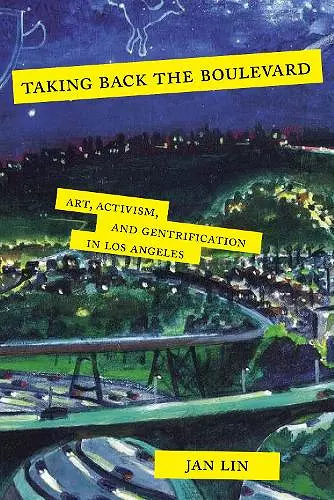Taking Back the Boulevard
Art, Activism, and Gentrification in Los Angeles
Format:Paperback
Publisher:New York University Press
Published:15th Jan '19
Currently unavailable, and unfortunately no date known when it will be back
This paperback is available in another edition too:
- Hardback£74.00(9781479809806)

The promises and conflicts faced by public figures, artists, and leaders of Northeast Los Angeles as they enliven and defend their neighborhoods
Los Angeles is well known as a sprawling metropolis with endless freeways that can make the city feel isolating and separate its communities. Yet in the past decade, as Jan Lin argues in Taking Back the Boulevard, there has been a noticeable renewal of public life on several of the city’s iconic boulevards, including Atlantic, Crenshaw, Lankershim, Sunset, Western, and Wilshire. These arteries connect neighborhoods across the city, traverse socioeconomic divides and ethnic enclaves, and can be understood as the true locational heart of public life in the metropolis.
Focusing especially on the cultural scene of Northeast Los Angeles, Lin shows how these gentrifying communities help satisfy a white middle-class consumer demand for authentic experiences of “living on the edge” and a spirit of cultural rebellion. These neighborhoods have gone through several stages, from streetcar suburbs, to disinvested neighborhoods with the construction of freeways and white flight, to immigrant enclaves, to the home of Chicano/a artists in the 1970s. Those artists were then followed by non-Chicano/a, white artists, who were later threatened with displacement by gentrifiers attracted by the neighborhoods’ culture, street life, and green amenities that earlier inhabitants had worked to create. Lin argues that gentrification is not a single transition, but a series of changes that disinvest and re-invest neighborhoods with financial and cultural capital.
Drawing on community survey research, interviews with community residents and leaders, and ethnographic observation, this book argues that the revitalization in Northeast LA by arts leaders and neighborhood activists marks a departure in the political culture from the older civic engagement to more socially progressive coalition work involving preservationists, environmentalists, citizen protestors, and arts organizers. Finally, Lin explores how accelerated gentrification and mass displacement of Latino/a and working-class households in the 2010s has sparked new rounds of activism as the community grapples with new class conflicts and racial divides in the struggle to self-determine its future.
Taking Back the Boulevard is exemplary in its ability to weave the strands of structure and agency together to show how real gentrified spaces are produced. And just as important, such complexity is delivered with clear prose and riveting stories. Although the book focuses on Northeast Los Angeles, its lessons are generalizable. Scholars and students of gentrification would enjoy reading the book and benefit from engaging with its core arguments. It is at once a labour of love by an established urban sociologist and an important contribution to the sprawling literature on the subject. -- International Journal of Urban and Regional Research
Taking Back the Boulevard is an excellent resource for scholars and researchers who see themselves as public intellectuals, as well as for individuals wishing to engage art and activism in urban communities. The text is accessible, comprehensive, and passionate. Lin offers a stimulating tales for which to approach Northeast L.A., transgenerational activism, and a community’s cycles of cultural and economic transition. -- Social Forces
Jan Lin has written both a meticulous and a passionate documentation of the long waves of investment, migration, and cultural expression that have shaped Northeast Los Angeles since the heyday of Anglo urbanization. From bohemianism and bike lanes, to tacos and lattes, Lin shows how embedded cultural patterns and determined community activists keep the vitality of the streets even in our most automobile-dependent city. -- Sharon Zukin,Author of Naked City: The Death and Life of Authentic Urban Places
In this heartfelt and meticulously researched history of the boulevard-lined neighborhoods of Northeast L.A., Jan Lin has given us a crucial and timely investigation into how local cultural and community movements, together with struggles over the right to the city, shape our contemporary urban landscapeWith imaginative theorization and brilliantly clear prose, Lin attends to the contradictions and conflicts of the current moment, as well as new, radical possibilities for a green and equitable city that are now also within sight. -- Miriam Greenberg,Co-editor of The City is the Factory: New Solidarities and Spatial Tactics in an Urban Age
Jan Lin has produced a deeply researched and beautifully written examination of more than a century of neighborhood change and activism in northeast Los Angeles ... Lin aims to take back the boulevards as a topic for urban sociology so that the continuity, growth, change, conflict, and drama of street life get a hearing in their own right. At this he succeeds admirably, and students of urban sociology at all levels have something to learn from entering into the world Lin has so skillfully depicted. * American Journal of Sociology *
ISBN: 9781479895700
Dimensions: unknown
Weight: 417g
256 pages